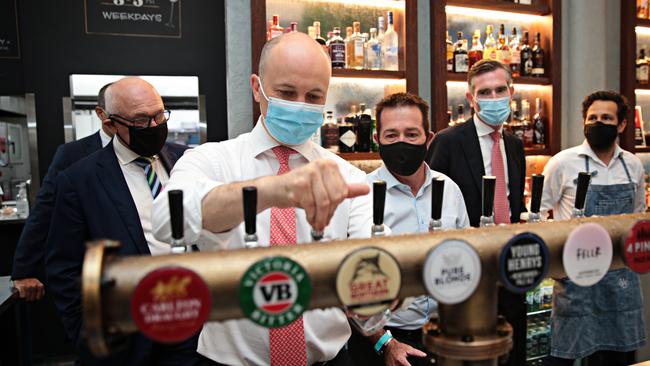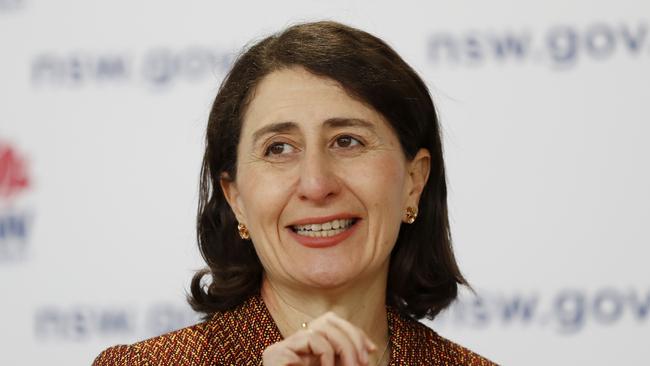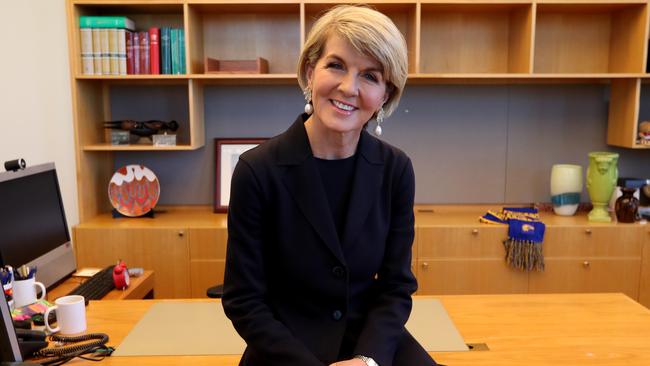Liberals once again dominated by males following Gladys Berejiklian’s departure
The dramatic departure of Gladys Berejiklian as NSW leader has once again highlighted just how far women still have to go to redress the balance of power in parliament.
NSW
Don't miss out on the headlines from NSW. Followed categories will be added to My News.
Celebrating freedom day by heading to the pub for schooners with the boys, the state’s new political leaders drew fire with a blokey photo opportunity this week.
Less than two weeks after the dramatic departure of the second female premier of NSW, Dominic Perrottet’s decision to mark the early steps out of lockdown with men in suits, including Treasurer Matt Kean and Deputy Premier Paul Toole, drew a collective shudder from many.
“I couldn’t believe what I was seeing,” said one senior female NSW politician of the photo, which was taken at a hotel celebrating its first day in business.
“It was like they decided to leave the ladies in the back bar with a shandy!”
Gladys Berejiklian’s sudden resignation ahead of ICAC hearings beginning next week sent shockwaves across the state, with many despairing at the loss of a popular leader who had steered NSW through calamitous bushfires and the ongoing pandemic.
Mr Perrottet’s cabinet now includes just two Liberal women, Sports Minister Natalie Ward and Local Government Minister Shelley Hancock.

With his sole focus on reopening the state, Mr Perrottet said he would hold off on a wholesale reshuffle until summer but conceded the party was lagging in representation.
“It is important for our government to boost the opportunities for women across the board and create better pathways from the most junior to senior roles,” he said.
“It’s something I will definitely be looking closely at as we refocus the government.”
Mr Perrottet’s leadership team will be compared with that of Opposition Leader Chris Minns, who when installed in June over Strathfield MP Jodi McKay assembled a shadow cabinet of 27 that was comprised of 13 women.
Got a news tip? Email weekendtele@news.com.au
They include deputy leader and shadow education spokesperson Prue Car, who this week described Ms Berejiklian’s departure as “disappointing” for many women.
“The parliament in NSW could do a lot better in terms of female representation and just generally representing the communities that we are here to advocate for and fight for,” Ms Car said.
“Even though I always have had, and still have, a lot of differences with Gladys Berejiklian, I don’t think that you could ever doubt her commitment, her hard work during very difficult times. So I think what has happened has been has been quite a big change. And I think people in NSW have a right to be a little bit shocked by the whole thing.”

For many the past few weeks have felt like a step back in time, but the images of an all-male leadership team in NSW were in fact a long time coming.
When the NSW Liberals swept into power 10 years ago Barry O’Farrell’s landslide was indeed a “manslide”, according to veteran MP and the first female president of the young Liberals, Catherine Cusack.
Sixteen years of Labor government ended with a historic 16.4 per cent swing to give the Coalition the biggest majority in the state’s history, but somehow – even while Australia had its first female PM in Julia Gillard – the number of women decreased from 28 per cent of lower house seats to about 20 per cent.
“The seats were falling into our laps but the results for women were very disappointing,” she said.
“When you get elected to government, that’s when you’re winning seats, so it’s easier to
improve the balance when you’ve got vacant seats.
“Where there’s a big increase in the number of women in a party, it comes from opposition, when your numbers are down. It’s very difficult to change your numbers to change your gender balance when you’re an incumbent government, it’s practically impossible.
“If you’ve got an incumbent party room and everyone says, ‘Oh, we need more women’, every man in that room is going to think ‘oh, that means my seat’ and they’re not going to be very supportive.”

Ms Cusack said this was starkly illustrated when former premier Mike Baird assigned his then-deputy, Ms Berejiklian, to work on improving the number of women in parliament.
“Well, that went over like a lead balloon in the party room,” she recalls.
“This was actually stated: ‘Which of you wants to yield your seat so that we can have a more gender friendly Liberal party?’
“They went round the room. It was a very smart thing to do, is all I can say, because it totally unhinged everybody and the boys went into a lather in the space of about 10 seconds.”
Australia’s drive to gender equality is going backward fast and we now rank 50th in gender diversity in leadership according to the World Economic Forum, down six from 2020 and down 24 from 2014. New Zealand ranks fourth.
The Liberal Party has long resisted calls for a Labor-style quota but there is growing support for change at grassroots level, particularly given how far from reaching the 2025 target of 50 per cent representation the party remains.

Former foreign Minister Julie Bishop, who has been outspoken about the Liberal party’s “gender deafness” and “misogyny” since leaving politics in 2019 and came out in favour of a 50-50 quota, recently said the 2025 target would be impossible to reach given it would mean more than 20 men would lose their seats.
“That’s not going to happen so they are going to have to adjust their focus and their target,” Ms Bishop told the ABC.
Ms Cusack said Liberals needed to look at introducing quotas, a notion strongly rejected by the party.
“But I think they can be done in a way that doesn’t make men feel targeted,” she said.
“You don’t get fairness to women by being unfair to men,” she says.
“We tried the merit process – we gave it a really good go and now it’s time to try something different.”
Professor Rosalind Dixon, an expert in constitutional law from the University of New South Wales, said public life had been made more difficult by the “polarised” and “critical” nature of social discourse.
“If you think about some of the comments that have been levelled against politicians of all stripes, male and female, it’s really polarised and really personal,” she said.
“And I think that’s a deterrent to good people going into public office.”

But many women had been galvanised by the advocacy of sexual assault survivors Grace Tame, the Australian of the Year, and former parliamentary staffer Brittany Higgins.
“I think that this moment is one that has made women feel both really discouraged and really angry and really motivated, in the same way that Donald Trump got women out in the streets,” Prof Dixon said.
“People are really motivated to make a contribution to creating social and political change. Injustice discourages, but it also motivates and mobilises people. And I think that’s one of the many powerful things that came through with these women, which was just, you know, we want to be part of the change.”
There were also increasing efforts to boost cultural diversity.
“Change is being made in party preselection processes that I think really are making improvements and changes and I would be extremely optimistic that not only will there be more female leaders, but more diverse female leaders,” she said.
“Getting more First Nations women and women from migrant backgrounds into politics is just as important as having women generally.”
Got a news tip? Email weekendtele@news.com.au




